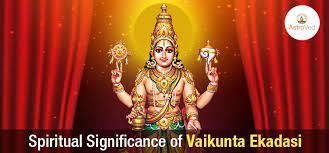What Is the Story Behind Vaikunta Ekadasi?

Ekadasi is the 11th day of every fortnight in a lunar month. In each month, there are 2 Ekadasis. Thus, there are 25 Ekadasis in a year. All Ekadasis are important to Vishnu devotees or Vaishnavites. But Vaikunta Ekadasi in the holy month of Margazhi (Dec-Jan) is very important. For, on this day, Hindus believe that those who observe a fast and worship Vishnu will be able to attain Moksha and the abode of Vishnu himself, Vaikunta.
Among Hindus, there is a practice of performing penance to please various deities and gain their blessings or to realize a wish. The most common form of penance is fasting, where the person avoids food completely or partially for one or more days. For Vishnu devotees, fasting on Ekadasi is a very important practice, and it supposedly brings many benefits, including the blessings of Lord Vishnu. In fact, it is said that no other practice is as powerful as fasting on Ekadasi.
The Padma Purana, as well as Chapters 36 and 40 of Uttara Kandam, claim that on the day of Vaikunta Ekadasi, Vishnu himself opens the gates of heaven and leads devotees inside.
The Story behind Vaikunta Ekadasi
Once, there was an Asura called Muran who was very powerful and delighted in waging war against the gods. The gods were no match for him and even lost the Kalpaka Vriksha to him during one of the battles. This was a divine, wish-fulfilling tree that emerged from the Milky Ocean during Samudra Manthan. Indra took it to heaven and planted it there. It is said that one reason why the Asuras waged war constantly with the Devas was to lay claim to these wish-granting trees. The gods enjoyed the "divine flowers and fruits" of the Kalpavriksha and led an affluent life, whereas the demons lived in penurious circumstances at the lower part of its trunk and roots.
Muran soon began to encroach further into heaven. The gods sought Vishnu’s help, and he promised to deal with the demon. However, Muran was not worried as even Vishnu’s Sudarshana chakra could not harm him, thanks to a boon. A fierce battle ensued between Vishnu and Muran, but Vishnu could not defeat him. Feeling tired, Vishnu took refuge in a cave in Badrinath and fell asleep. Muran followed him to the cave and prepared to attack him. Suddenly, a female form came out of Vishnu’s body and killed Muran.
Startled by the commotion, Vishnu woke up. On realizing what had happened, Vishnu was pleased and named the damsel Ekadasi. He told her to ask for a boon. She replied that she wanted Vishnu to deliver people from their sins and grant them Moksha if they observed a fast on that day. Vishnu agreed.
Srirangam Ranganathaswamy temple, also called Bhoologa Vaikuntam, Parthasarathy temple in Triplicane, Chennai, Ananthapadmanabhaswamy temple in Adyar, and the Srinivasa temple in Mylapore are some of the temples which celebrate Vaikunta Ekadasi grandly.
One can see children playing snakes and ladders on this day. The game has a symbolic meaning. It reminds us that on the ladder of Bhakti or devotion, we can ascend to heaven. But the snake, which represents our ego, can pull us down in life.
Significance of Vaikunta Ekadasi
The demon Muran symbolizes the Tamasic and Rajasic traits within us, like passion, anger, lust, inertia, etc. By observing Ekadasi fast, we can conquer these negative traits. This enables us to attain Vaikunta – the stage or place of no ‘Kuntitha’ or suffering caused by dullness, stupidity, and misery. It is believed that on this day, the Vaikunta Dwara or Swarga Vasal will open. The area surrounding the sanctum sanctorum is called Swarga Vasal. In Vishnu temples, a gateway is erected through which devotees pass symbolizing their entry into Vaikunta, Vishnu’s heavenly abode.
It was also on this day that Krishna made his discourse to Arjuna, which has come to be called the Bhagavad Gita or Song of God. Hence, this day is also known as Gita Jayanti.
Rituals of Vaikunta Ekadasi
Vishnu devotees undertake a strict fast on this day. They do not eat or drink anything. But some who have health problems or other issues undertake a partial fast. On the 10th day, or 'dashami,' one who wants to fast should only take one meal. On Ekadasi, a complete fast is observed. Those who observe a partial fast can have fruits and milk. Rice and cereals are not allowed.
Devotees offer special prayers and chant Vishnu’s name and Mantras on this day. They also engage in meditation and keep vigil on Vaikunta Ekadashi night, listening to stories about Vishnu and chanting Vishnu bhajans. People also visit Vishnu temples in the evening and take part in the Poojas and rituals.
It is important to maintain one’s chastity on this day.
On Ekadashi Tithi, one should arise early, during Brahma Muhurat (two hours before sunrise), if possible.
One can do meditation and then take Sankalpa (Pledge) to observe the vrat.
One should avoid rice, wheat, and lentils. Smoking and drinking alcohol are forbidden. Also, avoid eating onions, garlic, and non-vegetarian food.
One can have milk, fruits, and dishes like sabudana khichdi, sabudana vada, kuttu or singhare ki puri, and aloo sabzi.
One can chant the OM Namo Bhagavate Vasudevaya Mantra many times. Hymns dedicated to Vishnu can be sung, and one can chant the Vishnu Sahasranam.
It is good to perform charitable activities and donate food to the needy.
Ekadashi vrat is for self-control. Hence, be calm and polite and focus on God.
Post Your Ad Here
Comments